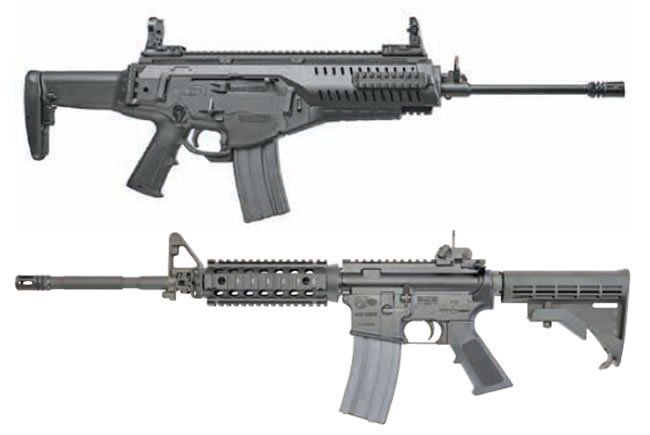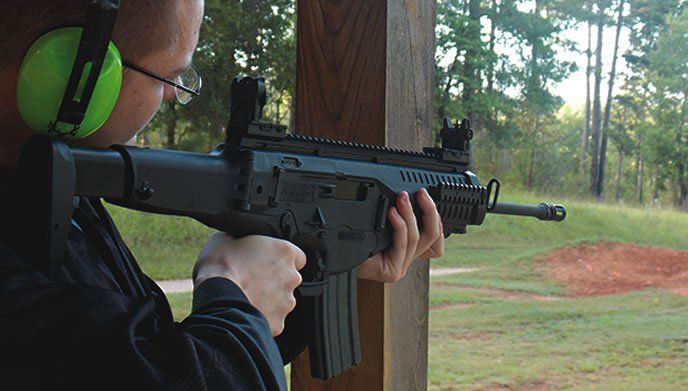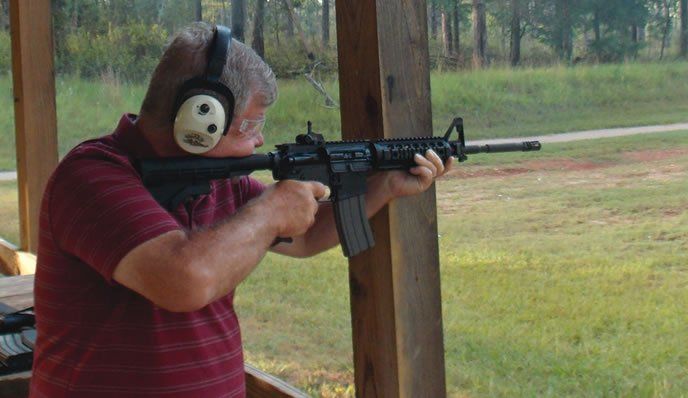If we were a rifle maker with a line of AR-15s, we might put up a neon sign outside our establishment that had an image of our carbine with a simple message below: “Millions and millions sold.” Because while that might not quite be true for an individual maker’s line, it is certainly true for the ArmaLite Rifle platform collectively. The various configurations of ARs are among the highest-selling rifle designs ever, and their appeal seems to keep broadening, even in the face of political restrictions in some jurisdictions.

Despite this popularity—or perhaps because of it—other designs suited for self defense want to take the AR down a notch, make a little cheddar for themselves at the expense of the standard defense rifle of our time. One such competitor du jour is the Beretta ARX 100, itself an adaptation of the successful ARX 160 military rifle made by the famous Italian gunmaker. The ARX 160 service rifle has shown up in several war zones, and it certainly is not an M16/M4/AR-15 rifle. In fact, the ARX platform has little in common with the AR, which could be a significant hurdle for commercial success, or perhaps the beginning of the next big thing. Which one is what we aimed to find out when we went shopping for a 5.56 NATO-chambered Beretta ARX 100 JXR11B00, $1522, a recent online price for the rifle at TombstoneTactical.com. We put it against a Colt M4 Carbine LE6920SOCOM, $1622, which we recently priced at a Houston-based firearms and floral-design store called Texas Guns and Roses (TexasGunsandRoses.com). This price also includes a $15 handling fee for online orders.
The disadvantage the Beretta had to overcome was that most experienced rifle shooters handle the AR-15 as if it were second nature. To help dial out some of that bias, we assembled a group of both novice and experienced raters for this project, one of whom has fired rifles, but never the AR-15 or the Beretta. With no prior AR-15 experience, we would see how quickly our novice could be brought up to speed on both rifles. Other shooters included a 20-year law-enforcement veteran, whose abstract on carbine training has been published on a federal level, and another rater who is a military captain recently returned from a fourteen-month deployment and a certified NRA instructor. We felt that this mix, along with other interested shooters, would help us pick the best battle rifle.

To test them, we used loads in different weights from several makers. We included Federal American Eagle 62-grain FMJ Green Tips (prior to the recent BATFE attempt at reclassifying them as armor piercing), Hornady 55-grain jacketed soft points, and Black Hills’ 77-grain Open-Tip Match. We also fired the Black Hills 52-grain Match, Hornady 55-grain Zombie Max, and Federal’s 55-grain JSP and Winchester’s 55-grain FMJs. Here’s what we found:

Beretta ARX 100 JXR11B00 5.56x45mm NATO (223 Rem.), $1522
The Beretta features polymer upper and lower receivers in an ergonomic shell. Our first impression when handling the ARX was that it was well balanced and felt lighter than it actually is. The rifle handled particularly well during benchrest firing, which surprised us because of the rounded shape of its forend.
The rifle is ambidextrous. Human beings are bilaterally symmetrical, and the ARX 100 may make the same claim. The usual firearm is designed for a right-handed person. Then some type of modification is made to the rifle to accommodate the left-handed shooter, but such modifications aren’t equal. This is an important consideration that civilians often overlook, but us, like soldiers, might find ourselves in a situation in which we need a rifle that may be fired equally well off either shoulder. This rifle was set up for right-hand use, but the difference between right- and left-hand operation is minimal.
For instance, the bolt handle was set up for conventional cocking, and some of the raters felt it was easier to manipulate than the AR-15’s cocking handle. Additionally, the cocking handle was easily removed and changed to the other side. Likewise, the ejection port is open on either side of the receiver, and there is no dust cover. To change the direction of cartridge ejection, the shooter pressed a bolt in the receiver to the left for left-hand ejection or to the right for right-hand ejection. This was easily accomplished with a bullet point. The safety was similar to the AR-15 and could be used on each side of the receiver. Our shooters thought the ARX safety handled well and was equal to the Colt’s in ease of use. Likewise, the magazine release appeared on both sides of the rifle. Another auxiliary, or emergency, magazine release was located in the trigger guard. We pondered just how useful this might be, but the military rater felt that it would be useful for gloved-hand manipulation. This release required considerable effort to activate, and seemed more like the AK than the AR type.
The bolt release was in the trigger guard. We found it worked well enough. During rapid manipulation, none of the raters pressed the wrong control, despite all of the AR-15 shooters having their muscle memory geared to that platform. Rapid magazine changes were not as quick and sharp as when we shot the Colt, but with practice, we sped up. Despite concerns that the magazine release and the bolt release were too close together, there was never a problem.
Colt M4 Carbine LE6920SOCOM 5.56×45 NATO
When firing the rifle, one of the raters noted that his hands were in contact with the safety. Two out of three raters noted this. The safety didn’t budge, but the feeling was odd enough for us to mention it. All the raters felt that the cocking handle was thin and uncomfortable to shoot after firing a few hundred rounds and racking the bolt to load the magazines. If the rifle had been run to the bolt lock, this wouldn’t have been an issue. The military-type trigger was heavier than we expected to find, with it breaking at 9.5 pounds. It was smooth enough, but it did feel heavy.
The sights were an original design. The front sight was the usual post similar to the AR-15. The rear sight has a rotating wheel, which was moved left to right depending upon the range at which you will be firing, from 100 to 600 yards with apertures for 100, 200, 300, 400, and 600 yards. Notably, the 100- and 200-yard apertures appear to be the same diameter, but they are set at different places in the wheel. Our shooters said the sight worked well.
The rail was a one-piece top Picatinny onto which optics may easily be mounted. There were also side rails, one on each side of the receiver, and a short rail on the bottom of the receiver. You may hold the receiver in a way that your hands will not be abraded by the rails, a welcome change from the cheese-grater front on the Colt. The adjustable-position stock equalled the Colt’s, and it also folded to the side, which gave it extra utility.
The rifle used a short-stroke piston design rather than the AR-15’s gas-impingement system. The rifle was designed to be run dry, without lubricant. We did just that, and by the time the test period was done, there were more than 500 rounds fired in the rifle with only a wipe down and a few patches run down the barrel. We never had a failure to feed, chamber, fire, or eject. (We did clean the bore before testing.)
We fired it extensively at combat ranges of 25, 50, and 100 yards, primarily with Winchester 55-grain FMJ loads. The rifle came to the shoulder quickly, and the iron sights gave us good hits. At longer ranges, we noticed how heavy the trigger was, and as you can see from the range data, we just weren’t that accurate with it.
The Beretta ARX 100 was designed to accept the NATO-standard STANAG magazine, which is a highly developed aluminum magazine. It is advertised as compatible with the AR-15 magazine, which isn’t strictly true in our experience. We used Brownells magazines, PMags, and others left over from the AR-15 magazine test, including several PMag Generation 3 units. The Gen 3 magazine includes an impact and dust cover, marking matrix, slimline floor plate, Maglevel windows, and, importantly, an overtravel insertion stop. We found that this stop prevented the Gen 3 mags from fully entering the Beretta’s magazine well. This is something to be aware of if you convert to the Beretta ARX.
Other features included the grip, which was molded into the lower receiver. While it fit most hands well, there is no changing it. There was an interesting adjustable gas block. “S” is the setting for standard loads. “N” is for Non Standard, which might be steel-cased loads or for use in directing more gas pressure when the rifle is very dirty.
Another advantage: The lower receiver may be removed, the barrel release pressed, and the barrel changed in about a minute. We stopped firing when the Beretta began smoking, but if the planned caliber conversions become available, the barrel-change feature is a real advantage in versatility.
When firing the Beretta, our least experienced rater felt that the rifle kicked less. The other raters did not feel the shuffling of the buffer, but the novice had to alert us to this. It probably isn’t that recoil impulse is lessened, but rather he noticed the lack of a buffer spring. In any case, the ARX was a comfortable rifle to fire. In combat firing at 50 to 100 yards, the rifle performed well, and our shooters could find little difference in the rifles in these fast-paced combat drills. However, our most experienced trainer noted that few shooters understand the value of properly extending the support arm to get close to the muzzle of the AR-15. This hold gives a real advantage in controlling the rifle and directing fire. With the Beretta, this forward hold isn’t possible. In drills using this technique, the Colt outperformed the Beretta in the hands of our police and military trained raters. However, all our raters felt the polymer forend was more comfortable to hold than the quad rail on the Colt.
Because the rifle’s disassembly is so different from what AR-15 shooters know and expect, we want to go into some detail on the process. Disassembling the ARX 100 for cleaning and maintenance requires several steps. No tools are required for disassembly or reassembly. To start, make sure the rifle is unloaded and on Safe, lock the bolt to the rear, and remove the barrel group. Further disassembly of the barrel group is not recommended.
Press the magazine release button on the right or left side of the receiver or the lower magazine release button on the bottom of the trigger guard and remove the magazine from the rifle. Then close the bolt carrier assembly by pulling the bolt handle back and releasing it or by depressing the left or right bolt catch levers. Depress the stock latch button and fold the stock to the right, exposing the retaining plate visible through the back of the receiver. Rotate the safety lever up past the safety position to the disassembly position; this will allow the retaining plate to be pressed in, releasing the lower receiver from the upper receiver.
Pull down on the lower receiver while holding the safety lever in the disassembly position and depressing the retaining plate through the back of the receiver. Remove the lower receiver from the upper receiver. Pull the bolt handle back until it aligns with the marks on the left and right sides of the receiver. Pulling out on the bolt handle will keep the bolt from moving forward and allow the bolt handle to pivot around its pin. Rotate the bolt handle until it is aligned with the length of the bolt, and pull the bolt-carrier assembly out the back of the receiver. Depress the barrel release levers on both sides of the receiver and pull the barrel forward and out of the receiver. The barrel cannot be removed if the bolt is closed.
Remove the recoil spring from the bolt carrier by pressing forward on the recoil spring assembly, then rotate the recoil spring guide 90 degrees. Pull the recoil spring assembly out the back of the bolt carrier. Remove the bolt from the bolt carrier by rotating the bolt handle to the right or left side (do not push the bolt handle into the bolt) and pull the bolt back through the bolt carrier, rotating it to allow the bolt cam to follow the cam path and remove it from the carrier. Remove the firing pin from the bolt by pressing in on the firing pin and pulling the bolt cam pin out of the bolt. Then pull the firing pin and spring out the back of the bolt. This completes field stripping.
It’s worth noting the barrel can be removed without disassembling the rest of the rifle. To remove the barrel without disassembling the rest of the rifle, pull the bolt handle back until the handle aligns with the marks on the receiver, and pull it out and rotate the handle into the ejection port so that the bolt carrier assembly is locked in place. Then remove the barrel.
Our Team Said: The ARX 100 had no malfunctions of any type, and in fact, the Beretta gets solid “A” grades on many other factors as well, including handling and its ambidextrous nature. However, to us, an overall “A” rating does not seem warranted. The ARX 100 costs twice as much as many excellent AR-15s, the accuracy was not as good as the Colt’s, and the trigger was too heavy. With an AR-15, we could buy a good replacement trigger, drop it in, and improve both the trigger response and probably the accuracy. But in a cursory search, we couldn’t locate a replacement trigger for the ARX 100, though Timney is reportedly working on one.
Colt M4 Carbine LE6920SOCOM 5.56×45 NATO (.223 Rem.), $1622
In most regards, this rifle is a civilian version of the military M4. The test rifle does not have a short barrel and a selector switch, of course, but otherwise it is similar. Fit, finish, and attention to detail are high with this rifle. The rifle featured an aluminum receiver and plastic furniture and a quad rail forend. At the butt was the proven four-position adjustable stock. The hollow grip fit most hands well, but if you don’t like it, it is easily changed. All AR-15 magazines we had on hand locked and functioned properly.
There are features that set this Colt apart from other AR-15s. The rail forend allowed plenty of room for mounting optics, lights, or lasers. The rail was plainly marked so that the devices may be removed and replaced with a high degree of confidence in the zero, in the case of optics. The front sight was the standard AR-15 post. The sight came set at the lowest position, requiring adjustment to find the zero. The rear sight was an interesting option. The pop-up post featured a single aperture. The sight allowed the shooter to set the range for 200 to 600 yards. We were able to easily set the sights for 100 yards for the evaluation. They are calibrated for the 62-grain load, according to Colt, and we found this to be true, but we were able to get useful results with other bullet weights. The sights gave good results in both combat firing and absolute accuracy testing, as the range data table nearby shows.
The trigger was heavier than we like at 7 pounds. While lighter than the Beretta and with a smoother let off, it was still heavy and needed adjustment or replacement, in our opinion.
The Colt is not ambidextrous in the same sense as the Beretta, but the LE6920 is still a useful firearm if you have to switch shoulders. The Colt featured an ambidextrous safety lever, and we found it worked well on both sides. To actuate the magazine release, the left-handed shooter must move the forward hand rearward, a move which should be practiced but which is by no means difficult.
The Colt was broken in with Winchester USA ball ammunition. In rapid fire and combat firing at moderate ranges and also at 100-yard targets, the Colt performed well for our shooters. In particular, the Colt exhibited brilliantly rapid magazine changes that were not possible with the Beretta — not that the Beretta is slow — the Colt carbine was simply very fast in replenishing the ammunition supply. During combat shooting, our testers said the Colt handled well, but for extended range sessions the shooters need to deploy gloves or rail covers. If you lightly hold the rifle and target shoot, this isn’t an issue. But using the proper techniques and working the forend properly, the rifle must be grasped tightly, and the rail isn’t that comfortable.
In our attempts at precision fire, taking every advantage from a solid benchrest position, we were able to achieve only fair results with the Colt. The Black Hills 77-grain MK III gave us a 1.5-inch 50-yard group average. Optics would certainly help improve accuracy, but this rifle is already pricey, so we don’t want to assume you’ve got an unlimited budget.
The Colt is clearly accurate enough for any role in personal defense or 3 Gun competitions. The Colt will accept a myriad of aftermarket accessories, including trigger upgrades and stocks, while the Beretta has few available. Nor could items built for other platforms be easily adapted to ARX 100.
Our Team Said: Our novice felt that the Colt was the best handling for his needs, overall. And in the hands of the most experienced raters, the Colt outperformed the Beretta. The Colt is capable and proven. It is a good rifle at a premium price..
Written and photographed by R.K. Campbell, using evaluations from Gun Tests team testers.



























